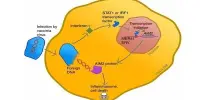Niche construction is the process in which an organism alters its own (or other species’) environment, often but not always in a manner that increases its chances of survival. Changes that organisms bring about in their worlds that are of no evolutionary or ecological consequence are not examples of niche construction. Several biologists have argued that niche construction is as important to evolution as natural selection (i.e., not only does an environment cause changes in species through selection but species also cause changes in their environment through niche construction). This back-and-forth creates a feedback relationship between natural selection and niche construction: when organisms affect their environment, that change can then cause a shift in what traits are being naturally selected for. The effect of niche construction is especially pronounced in situations where environmental alterations persist for several generations, introducing the evolutionary role of ecological inheritance. Less drastic niche-constructing behaviors are also quite possible for an organism. This theory, in conjunction with natural selection, shows that organisms inherit two legacies from their ancestors: genes and a modified environment. Together, these two evolutionary mechanisms determine a population’s fitness and what adaptations those organisms develop in the continuation of their survival.
Examples
- Earthworms: Through a process of modification, earthworms chemically alter the soil in which they live. This change in soil chemistry stimulates an increased fitness in earthworm populations. The subsequent chemical composition of soil produced by earthworm activity also benefits the growth of proximal species of plants and other biota present in the soil.
- Lemon Ants (Myrmelachista schumanni): This species of ants employs a specialized method of suppression that regulates the growth of certain trees. Lemon ants make their homes in the bodies of Duroia hirsuta, a species of tree found in the Amazonian rainforest of Peru. To ensure the prevalence of Duroia trees, Lemon ants employ self-derived quantities of formic acid (a chemical fairly common among species of ants) as a tenacious herbicide. The end result alters the composition of their forest habitat drastically by wiping out arboreal species ill-suited for colony habitation. When observed by humans, the subsequent altered ecologies perpetuated by these ants have been termed the Devil’s Gardens.
- Beavers: In the construction of their dams, beavers drastically shape and alter the ecosystem in which they live. Deforestation, effects on soil structure, root structure, turbidity of water, allocation of water and the supply of water downstream are just a handful of exemplars defining beaver niche construction. Beavers express a clear example of the diverse effects perpetuated by the construction of a niche. In the mammalian kingdom beavers are one of the greatest proximal modifiers.
- Diatoms in the Bay of Fundy, Canada, provide another example of an ecosystem engineer. Benthic diatoms living in estuarine sediments secrete carbohydrate exudates that bind the sand and stabilize the environment. The diatoms cause a physical state change in the properties of the sand that allows other organisms to colonize the area. The concept of ecosystem engineering brings new conceptual implications for the discipline of conservation biology.
- Pine Trees & Chaparrals: Chaparrals and pines have been found to express niche constructing behavior in response to the effects of forest fire. These trees and shrubs increase the frequency of fire by affecting the composition of the forest floor. They achieve this end through the dispersal of needles, cones, seeds and oils, essentially littering the forest floor. The benefit of this activity is compounded by an adaptation in these particular flora that has selected for a resistance to fire. The evolutionary exchange (made between both niche construction and natural selection) allows the fire-resistant pine and chaparral to exploit the chemical change that occurs in soil after organic matter has been burned.
Implications
Niche construction has many implications for the human sciences, more specifically human sociobiology, evolutionary psychology, and human behavioral ecology. Standard evolutionary theory only allows for cultural processes to affect genetic evolution by influencing the individual and depends on the ability of that individual to survive and pass on its genes to the next generation. Cultural processes are viewed merely as an aspect of the human phenotype and are not believed to be consequential to human evolution. Cultural diversity is believed to reflect variation in the environments that different populations of humans evolved in, and nothing else. This theory overlooks the fact that humans can modify their selective environments through cultural activity, thus feeding back to affect selection. “Cultural processes add a second knowledge inheritance system to the evolutionary process through which socially learned information is accrued, stored, and transmitted between individuals both within and between generations.”
With the addition of language to the human culture came an increased mental capacity. This allowed for human adaptation of the environment to be a learned process, unlike nonhuman species, whose adaptive process is instinctual. This resulted in the acceleration of environmental, behavioral, and genetic modifications. As niche construction advocate Derek Bickerton writes, “We could construct our niches without having to wait on interminable rounds of feedback between genes and behavior.”
A theory on gene-culture coevolution calls for a more integrated relationship between genetic evolution and cultural processes than standard evolutionary theory. In this model, cultural activities are believed to affect the evolutionary process by modifying selection pressures. In other words, cultural change has the capacity to codirect its population’s genetic evolution. Mathematical and conceptual models including investigations of language, handedness, the emergence of incest taboos, the coevolution of hereditary deafness and sign language, and sexual selection with a culturally transmitted mating preference demonstrate this theory. However, this theory is still dependent on standard evolutionary theory because it requires that cultural processes only affect genes directly, not allowing for any intermediate factors in the environment to interact with these processes at an evolutionary level. This theory exists on a dual inheritance system consisting solely of genes and cultural activity. “The dual inheritance system is a way to include interactions between nature and nurture in a tractable system.” In most cases this theory works smoothly, however, there are instances where cultural activities create changes in the abiotic environment that then affect selection pressures.
















